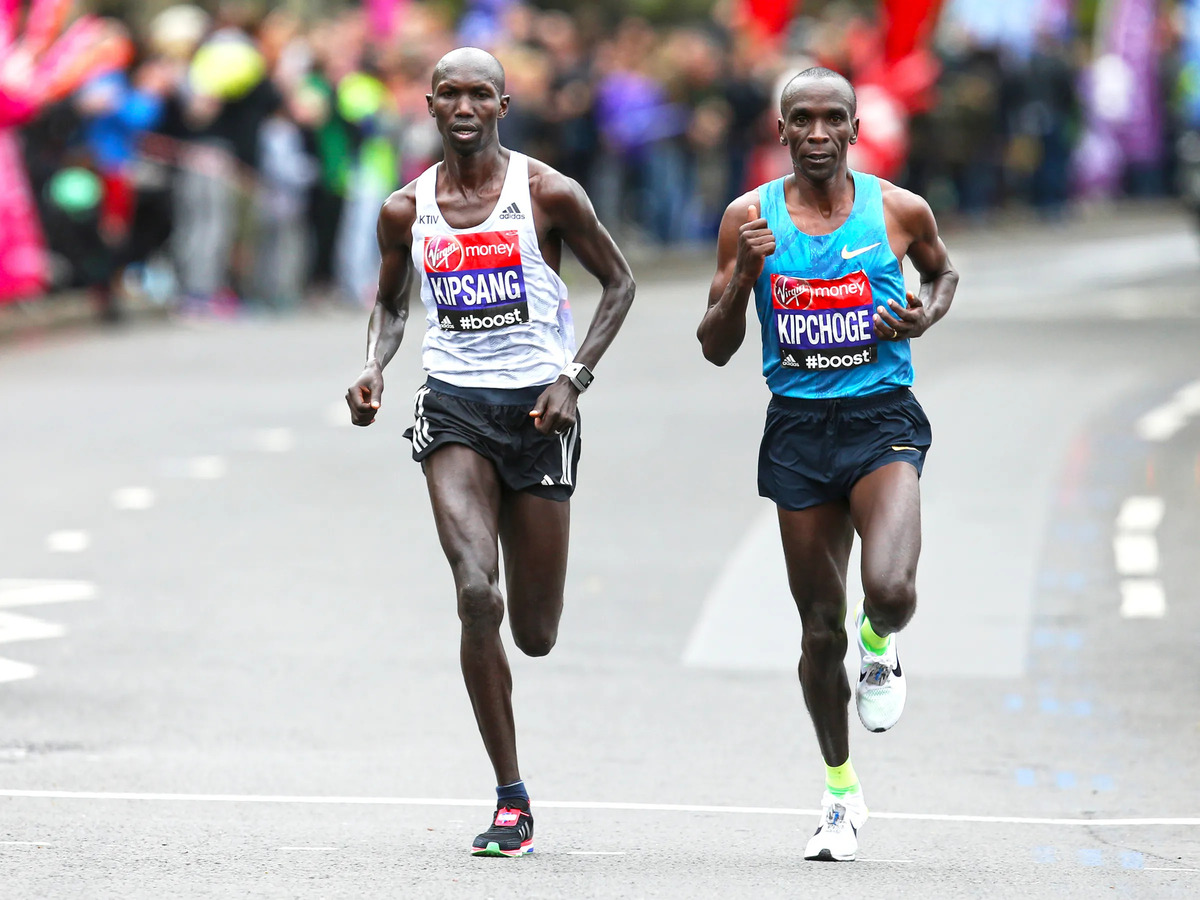Home>Misc>Featured>Which Muscle Fiber Type Is Best Suited For Endurance Activities Such As Long-Distance Jogging


Featured
Which Muscle Fiber Type Is Best Suited For Endurance Activities Such As Long-Distance Jogging
Modified: January 2, 2024
Discover which muscle fiber type is best suited for endurance activities such as long-distance jogging. Learn how to optimize your training for maximum performance and results. Featured.
Introduction
When it comes to endurance activities, such as long-distance jogging, the type of muscle fibers in our bodies play a crucial role in determining our performance and stamina. Understanding the different muscle fiber types and their suitability for endurance activities can help improve training strategies and optimize results.
Muscle fibers are the individual cells that make up our muscles. They are responsible for generating the force required for movement. There are three primary types of muscle fibers: slow-twitch (Type I), fast-twitch oxidative (Type IIa), and fast-twitch glycolytic (Type IIb).
Each muscle fiber type has distinct characteristics and capabilities. Slow-twitch muscle fibers are well-suited for endurance activities due to their high resistance to fatigue and efficient energy production. On the other hand, fast-twitch oxidative and fast-twitch glycolytic muscle fibers are more suited for short bursts of intense activity.
In this article, we will explore the different muscle fiber types and delve into which one is best suited for endurance activities like long-distance jogging. By understanding the role of each muscle fiber type, we can make informed decisions and tailor our training programs to achieve optimal performance and endurance.
What are muscle fibers?
Muscle fibers are the building blocks of our muscles. They are long, cylindrical cells that contract and generate the force needed for movement. These fibers are classified based on their structural and functional properties.
At a microscopic level, muscle fibers are composed of myofibrils, which are further composed of smaller units called sarcomeres. Sarcomeres consist of two types of protein filaments – actin and myosin – that slide past each other when the muscle contracts.
There are three main types of muscle fibers: slow-twitch (Type I), fast-twitch oxidative (Type IIa), and fast-twitch glycolytic (Type IIb).
Slow-twitch (Type I) muscle fibers are characterized by their high endurance capacity and resistance to fatigue. These fibers have a rich supply of mitochondria, which are responsible for aerobic energy production. Slow-twitch fibers rely primarily on oxidative metabolism, using oxygen to generate adenosine triphosphate (ATP), the main energy source for muscle contractions.
Fast-twitch oxidative (Type IIa) muscle fibers also possess a good endurance capacity but have a higher contraction speed than slow-twitch fibers. They have a greater reliance on aerobic metabolism and possess a combination of oxidative and glycolytic properties.
Fast-twitch glycolytic (Type IIb) muscle fibers, also known as fast-twitch or type IIx fibers, are characterized by their ability to generate high levels of force quickly. They contract rapidly but fatigue more easily compared to slow-twitch fibers. These fibers predominantly use glycolytic metabolism, relying on stored glycogen for energy production.
It is important to note that individuals can have varying proportions of these different muscle fiber types. Genetic factors, training, and physical activity patterns can influence the distribution and characteristics of muscle fibers in an individual’s body.
Types of muscle fibers
Muscle fibers can be classified into three main types based on their structural and functional characteristics: slow-twitch (Type I), fast-twitch oxidative (Type IIa), and fast-twitch glycolytic (Type IIb). Each type has distinct properties that determine their performance during different types of physical activities.
1. Slow-twitch (Type I) muscle fibers: These fibers are best suited for endurance activities that require prolonged and repeated muscle contractions, such as long-distance jogging and cycling. Slow-twitch muscle fibers have a high resistance to fatigue and can sustain low-intensity contractions for extended periods. They are also highly efficient in using oxygen to produce energy through aerobic metabolism. Due to their endurance capabilities, slow-twitch fibers are essential for maintaining a steady pace in endurance activities.
2. Fast-twitch oxidative (Type IIa) muscle fibers: These fibers possess a combination of endurance and speed characteristics. They can contract more rapidly than slow-twitch fibers and have a good resistance to fatigue. Fast-twitch oxidative fibers rely on both aerobic and anaerobic pathways for energy production. They are particularly important for activities that involve moderate to high-intensity efforts over longer durations, such as sprinting, middle-distance running, and swimming.
3. Fast-twitch glycolytic (Type IIb) muscle fibers: These fibers are designed for short, explosive bursts of power and force production. They contract quickly and generate high levels of force but tire rapidly. Fast-twitch glycolytic fibers primarily rely on anaerobic metabolism, breaking down stored glycogen for energy. As a result, they are well-suited for activities that require intense and rapid movements, such as weightlifting, jumping, and short sprints.
It’s important to note that individuals differ in their proportion of muscle fiber types. Genetic factors, training, and physical activity patterns can influence the distribution of muscle fiber types within the body. Some individuals may naturally have a higher proportion of slow-twitch fibers, while others may have a higher proportion of fast-twitch fibers.
Understanding the different types of muscle fibers and their characteristics is essential for tailoring training programs and maximizing performance in specific activities. By identifying the dominant muscle fiber type, individuals can focus on developing the necessary endurance or explosive power needed for their preferred physical pursuits.
Type I: Slow-twitch muscle fibers
Slow-twitch muscle fibers, also known as Type I fibers, are well-suited for endurance activities that require prolonged muscle contractions, such as long-distance jogging, cycling, and swimming. These fibers are characterized by their high resistance to fatigue and ability to sustain low-intensity contractions for extended periods. Here are the key characteristics of slow-twitch muscle fibers:
- Efficient energy production: Slow-twitch fibers rely primarily on oxidative metabolism, which utilizes oxygen to generate energy through the breakdown of carbohydrates and fats. They have a rich supply of mitochondria, the cellular powerhouses responsible for aerobic energy production.
- High endurance capacity: Slow-twitch fibers are equipped with a network of blood vessels that supply a steady stream of oxygen and nutrients. This allows them to sustain contractions over long periods without fatigue.
- Slow contraction speed: Due to their reliance on oxidative metabolism, slow-twitch fibers have a slower contraction speed compared to fast-twitch fibers. This makes them better suited for activities that require a steady and prolonged effort, rather than rapid bursts of power.
- Greater capillary density: Slow-twitch muscle fibers have a higher density of capillaries surrounding them, allowing for efficient oxygen and nutrient delivery. This enhances their endurance capabilities and supports prolonged muscle activity.
- Lower force production: Slow-twitch fibers produce less force compared to fast-twitch fibers. However, they have a greater ability to sustain contractions over time without fatigue.
Slow-twitch muscle fibers play a crucial role in endurance sports and activities that require maintaining a steady pace. They provide the foundation for prolonged aerobic work and are responsible for the ability to sustain a continuous effort over long distances.
To optimize the development of slow-twitch muscle fibers, endurance training methods are typically employed. This involves performing activities at a moderate intensity for an extended period. Examples include long-distance running, cycling, swimming, and activities that involve low-intensity, prolonged muscle contractions.
By focusing on training techniques that target slow-twitch muscle fibers, individuals can enhance their endurance capacity and improve performance in endurance activities. It’s important to note that slow-twitch muscle fibers can be developed and improved with consistent training, allowing individuals to increase their endurance capabilities over time.
Type IIa: Fast-twitch oxidative muscle fibers
Fast-twitch oxidative muscle fibers, also known as Type IIa fibers, possess characteristics that make them well-suited for activities that require a combination of endurance and speed. These fibers have a moderate resistance to fatigue and can contract more rapidly than slow-twitch fibers. Here are the key features of Type IIa muscle fibers:
- Efficient energy production: Fast-twitch oxidative fibers rely on both oxidative and glycolytic metabolism for energy production. They have a good supply of mitochondria, enabling them to generate energy through both aerobic and anaerobic processes.
- Moderate endurance capacity: While not as fatigue-resistant as slow-twitch fibers, Type IIa fibers have a reasonable endurance capacity. They can sustain contractions for a moderate duration, making them suitable for activities that involve a combination of endurance and speed.
- Rapid contraction speed: Compared to slow-twitch fibers, Type IIa fibers contract more rapidly. This allows for quick and explosive movements, making them ideal for activities that require bursts of speed and power.
- Intermediate force production: Fast-twitch oxidative fibers have a higher force production capability compared to slow-twitch fibers. Though not as powerful as fast-twitch glycolytic fibers, they have the ability to generate a moderate amount of force.
- Adaptability to training: Type IIa muscle fibers can adapt to different training stimuli. With proper training, they can shift towards being more glycolytic, acquiring characteristics similar to fast-twitch glycolytic fibers.
Fast-twitch oxidative muscle fibers are important for activities that require a combination of endurance and speed, such as middle-distance running, sprinting, and swimming. They contribute to the ability to maintain a relatively high intensity over a moderate duration.
Training methods aimed at developing Type IIa fibers involve a mix of aerobic and anaerobic exercises. This includes activities that challenge both the oxidative and glycolytic energy systems, such as interval training and tempo runs. These exercises involve alternating between high-intensity bursts and lower-intensity recovery periods, allowing the body to adapt and improve its efficiency in utilizing energy.
By targeting the development of Type IIa muscle fibers, individuals can improve their endurance capacity while also enhancing their ability to generate speed and power. This can lead to improved performance in activities that require a combination of both endurance and speed.
Type IIb: Fast-twitch glycolytic muscle fibers
Fast-twitch glycolytic muscle fibers, also known as Type IIb fibers, are designed for short, explosive bursts of power. These fibers contract rapidly and generate high levels of force but fatigue more quickly compared to slow-twitch and fast-twitch oxidative fibers. Here are the key characteristics of Type IIb muscle fibers:
- Fast contraction speed: Type IIb fibers contract more rapidly than both slow-twitch and Type IIa fibers. This allows for quick and powerful movements, making them essential for activities that require explosive strength and speed.
- High force production: Fast-twitch glycolytic fibers have the highest force production capability among the different muscle fiber types. They are responsible for generating the majority of the force required for intense physical activities, such as weightlifting, jumping, and short sprints.
- Low endurance capacity: Type IIb fibers fatigue more quickly compared to slow-twitch and Type IIa fibers. Due to their reliance on anaerobic metabolism, which uses stored glycogen as the energy source, they cannot sustain contractions for extended periods.
- Low oxidative capacity: Fast-twitch glycolytic fibers have fewer mitochondria compared to other muscle fiber types. This results in a limited ability to use oxygen for energy production, making them primarily reliant on anaerobic glycolysis.
- Efficient energy production: While Type IIb fibers rely on anaerobic glycolysis for energy, they can generate ATP at a rapid rate. This allows for quick bursts of power, making them well-suited for explosive movements.
Fast-twitch glycolytic muscle fibers play a crucial role in activities that require short bursts of intense effort. They provide the power and force necessary for activities like weightlifting, sprinting, and jumping.
To develop Type IIb muscle fibers, training methods that target anaerobic capacity and explosive strength are employed. These include exercises that involve high-intensity interval training (HIIT), plyometrics, and resistance training with heavy weights.
It’s worth noting that the proportion of fast-twitch glycolytic fibers in individuals can vary. Some individuals may naturally have a higher percentage of Type IIb fibers, which can give them a genetic advantage in explosive power activities.
By understanding the characteristics of Type IIb muscle fibers and implementing targeted training strategies, individuals can maximize their explosive strength and performance in activities that require short bursts of power.
Characteristics of endurance activities
Endurance activities are physical exercises or sports that require sustained effort over a prolonged period. These activities challenge the cardiovascular system, muscles, and energy systems, and typically involve low-to-moderate intensity levels. Understanding the key characteristics of endurance activities can help optimize training and performance. Here are some important features:
- Prolonged duration: Endurance activities involve performing physical exercises for an extended period. These activities can range from long-distance jogging and cycling to swimming, rowing, or participating in endurance races.
- Steady intensity: Endurance activities are typically performed at a steady and consistent intensity level. The goal is to maintain a pace that can be sustained for the entire duration of the activity.
- Aerobic energy production: Endurance activities primarily rely on the aerobic energy system, where the body utilizes oxygen to generate energy. This allows for the sustained production of adenosine triphosphate (ATP), the main energy currency of cells.
- Muscular endurance: With endurance activities, the emphasis is on the ability of muscles to sustain contractions over time. This requires the endurance capacity of both slow-twitch and fast-twitch oxidative muscle fibers.
- Moderate force production: While some endurance activities may require moderate force production, the primary focus is on maintaining a consistent effort rather than generating maximum power or force.
- Cardiovascular fitness: Endurance activities place a significant demand on the cardiovascular system. The heart and lungs work together to deliver oxygen-rich blood to the muscles, ensuring their proper functioning and stamina.
- Mental endurance: Endurance activities also test an individual’s mental stamina and resilience. The ability to stay focused and motivated throughout the activity is essential for maintaining a steady pace and achieving optimal performance.
Endurance activities offer a range of benefits, including improved cardiovascular health, enhanced muscular endurance, increased aerobic capacity, and the potential to burn calories and promote weight loss. Engaging in regular endurance training can help improve an individual’s overall stamina and performance in various physical activities.
Understanding the characteristics of endurance activities is crucial for designing effective training programs and preparing the body for the specific demands of these activities. By targeting the appropriate muscle fibers and energy systems, individuals can optimize their performance and achieve their endurance goals.
Endurance activities and muscle fiber types
The type of muscle fibers in our bodies plays a significant role in determining our performance in endurance activities. Different endurance activities place varying demands on the muscles, and certain muscle fiber types are better suited for specific types of endurance activities. Here’s how different muscle fiber types contribute to endurance activities:
- Slow-twitch muscle fibers (Type I): Slow-twitch fibers excel in endurance activities that require sustained, low-intensity contractions over a prolonged period. They have a high resistance to fatigue and are capable of utilizing oxygen efficiently for energy production through aerobic metabolism. Endurance activities like long-distance jogging, cycling, and swimming heavily rely on slow-twitch muscle fibers for sustained muscle contractions and endurance capacity.
- Fast-twitch oxidative muscle fibers (Type IIa): Fast-twitch oxidative fibers also contribute to endurance activities, but to a lesser extent than slow-twitch fibers. They can sustain moderate-intensity contractions for a period of time and have a good endurance capacity. Activities like middle-distance running, sprinting, and swimming involve a mix of both endurance and speed, and fast-twitch oxidative muscle fibers play a significant role in meeting the demands of these activities.
- Fast-twitch glycolytic muscle fibers (Type IIb): Fast-twitch glycolytic fibers are not as well-suited for endurance activities due to their low endurance capacity and rapid fatigue. However, they can still contribute to endurance activities that involve short bursts of intense effort, such as interval training or uphill sprints. These fibers primarily rely on anaerobic metabolism and provide the power and force needed for explosive movements.
It’s important to note that endurance activities often require the coordinated effort of multiple muscle fiber types. The proportion of each fiber type in an individual can vary and can be influenced by genetic factors, training, and physical activity patterns.
Training specifically targeting the necessary muscle fiber types for a particular endurance activity can optimize performance. For example, endurance training programs focusing on slow-twitch fibers might include long, steady-state runs or bike rides, whereas programs aiming to improve Type IIa fibers might involve interval training and tempo runs.
By understanding the contributions of different muscle fiber types and tailoring training programs accordingly, individuals can enhance their endurance capacity and improve their performance in specific endurance activities.
Benefits of slow-twitch muscle fibers for endurance activities
Slow-twitch muscle fibers, also known as Type I fibers, offer unique benefits for endurance activities. These fibers are well-suited for sustained, low-intensity efforts over prolonged periods. Here are some key advantages of slow-twitch muscle fibers in endurance activities:
- High resistance to fatigue: Slow-twitch fibers have a remarkable ability to resist fatigue. They can sustain contractions for extended durations without tiring easily. This endurance capacity is crucial for activities like long-distance jogging, cycling, and swimming, where maintaining a steady pace is essential.
- Efficient energy production: Slow-twitch muscle fibers primarily rely on aerobic metabolism, which uses oxygen to generate energy. With a rich supply of mitochondria, these fibers can efficiently produce energy through the breakdown of carbohydrates and fats. This makes slow-twitch fibers well-suited for endurance activities that require a steady, prolonged effort.
- Enhanced oxygen utilization: Slow-twitch fibers have a higher capillary density compared to other muscle fiber types. This means they have more blood vessels surrounding them, allowing for efficient oxygen delivery. The improved oxygen utilization supports sustained muscle contractions and endurance performance.
- Greater aerobic capacity: Slow-twitch muscle fibers possess a high oxidative capacity, meaning they can effectively utilize oxygen to generate ATP, the energy source for muscle contractions. This gives them an advantage in endurance activities that rely on aerobic metabolism.
- Supports maintaining a steady pace: Slow-twitch fibers contribute to maintaining a consistent and steady pace in endurance activities. They help individuals maintain an efficient level of effort over a prolonged duration, ensuring energy availability without rapid fatigue.
- Improved muscular endurance: Endurance activities promote the development of slow-twitch muscle fibers, resulting in enhanced muscular endurance. These fibers adapt and become more efficient at sustaining contractions, allowing individuals to perform at a higher level for longer durations.
Developing and maximizing the potential of slow-twitch muscle fibers is critical for improving performance in endurance activities. By incorporating endurance training methods, such as long, steady-state runs, cycling sessions, and other low-intensity, prolonged activities, individuals can enhance their slow-twitch muscle fiber function and endurance capacity.
It’s important to note that even individuals with a higher proportion of fast-twitch muscle fibers can benefit from developing their slow-twitch fibers. Slow-twitch muscle fibers contribute to overall endurance and can help improve performance and stamina in a wide range of endurance activities.
Benefits of fast-twitch oxidative muscle fibers for endurance activities
Fast-twitch oxidative muscle fibers, also known as Type IIa fibers, offer unique advantages for endurance activities that require a combination of endurance and speed. While not as fatigue-resistant as slow-twitch fibers, fast-twitch oxidative fibers provide valuable benefits in endurance sports. Here are some key advantages of fast-twitch oxidative muscle fibers in endurance activities:
- Moderate endurance capacity: Fast-twitch oxidative fibers exhibit a reasonable endurance capacity compared to fast-twitch glycolytic fibers. They can sustain moderate-intensity contractions for a period of time, making them better suited for activities that involve a mix of endurance and speed like middle-distance running, sprinting, and swimming.
- Efficient energy production: Fast-twitch oxidative fibers possess a mix of oxidative and glycolytic characteristics. This allows them to efficiently generate energy through both aerobic and anaerobic pathways. They can utilize oxygen for energy production and switch to anaerobic metabolism when necessary during high-intensity efforts.
- Good resistance to fatigue: While not as fatigue-resistant as slow-twitch fibers, fast-twitch oxidative fibers exhibit a higher resistance to fatigue compared to fast-twitch glycolytic fibers. This enables individuals to sustain a moderate-intensity effort for a longer duration.
- Rapid contraction speed: Fast-twitch oxidative fibers contract more rapidly than slow-twitch fibers. This makes them well-suited for activities that require bursts of speed and quick accelerations during endurance events.
- Improved aerobic capacity: Endurance activities that target fast-twitch oxidative fibers enhance aerobic capacity and improve the oxygen transport and utilization systems within the muscle. This leads to greater endurance and performance gains in both endurance-focused and speed-focused activities.
- Ability to adapt to different challenges: Fast-twitch oxidative muscle fibers are adaptable and responsive to different types of training stimuli. With proper training, these fibers can shift towards being more glycolytic, acquiring characteristics similar to fast-twitch glycolytic fibers. This flexibility allows individuals to excel in both endurance and speed-based activities.
To optimize the development of fast-twitch oxidative muscle fibers, individuals can incorporate training methods that target both the aerobic and anaerobic energy systems. Interval training, tempo runs, and other high-intensity workouts can challenge these fibers and improve their endurance capacity.
By specifically targeting fast-twitch oxidative muscle fibers, individuals can enhance their endurance performance, improve their ability to sustain moderate-intensity efforts, and excel in activities that require a combination of endurance and speed.
Conclusion
Understanding the different types of muscle fibers and their suitability for endurance activities is crucial for optimizing performance and achieving desired goals. Slow-twitch muscle fibers (Type I) play a vital role in endurance activities, providing high resistance to fatigue, efficient energy production, and the ability to sustain low-intensity contractions over prolonged durations. Fast-twitch oxidative muscle fibers (Type IIa) contribute to both endurance and speed-based activities, with moderate endurance capacity, efficient energy production, and rapid contraction speed. Fast-twitch glycolytic muscle fibers (Type IIb) are more suited for explosive, high-intensity activities due to their high force production but limited endurance capacity.
Endurance activities require a balance between stamina, efficiency, and power. Enhancing the performance in endurance activities hinges on developing the appropriate muscle fiber types. Tailoring training programs to target specific muscle fiber types can optimize performance and improve endurance capacity.
Whether you participate in long-distance jogging, cycling, swimming, or other endurance activities, understanding the characteristics and benefits of different muscle fiber types can help you train effectively and reach your maximum potential. By combining endurance training, interval training, and other targeted exercises, individuals can improve their endurance capacity, muscular endurance, and overall performance in endurance activities.
Remember, each individual has a unique distribution of muscle fiber types, influenced by genetic factors and training practices. Therefore, it’s essential to embrace these differences and work with your strengths while also challenging muscle fibers to maximize their potential.
Ultimately, achieving success in endurance activities requires a balanced training approach, proper nutrition, and dedication. By understanding the role of muscle fiber types and employing effective training strategies, individuals can unlock their full potential and excel in their chosen endurance pursuits.









